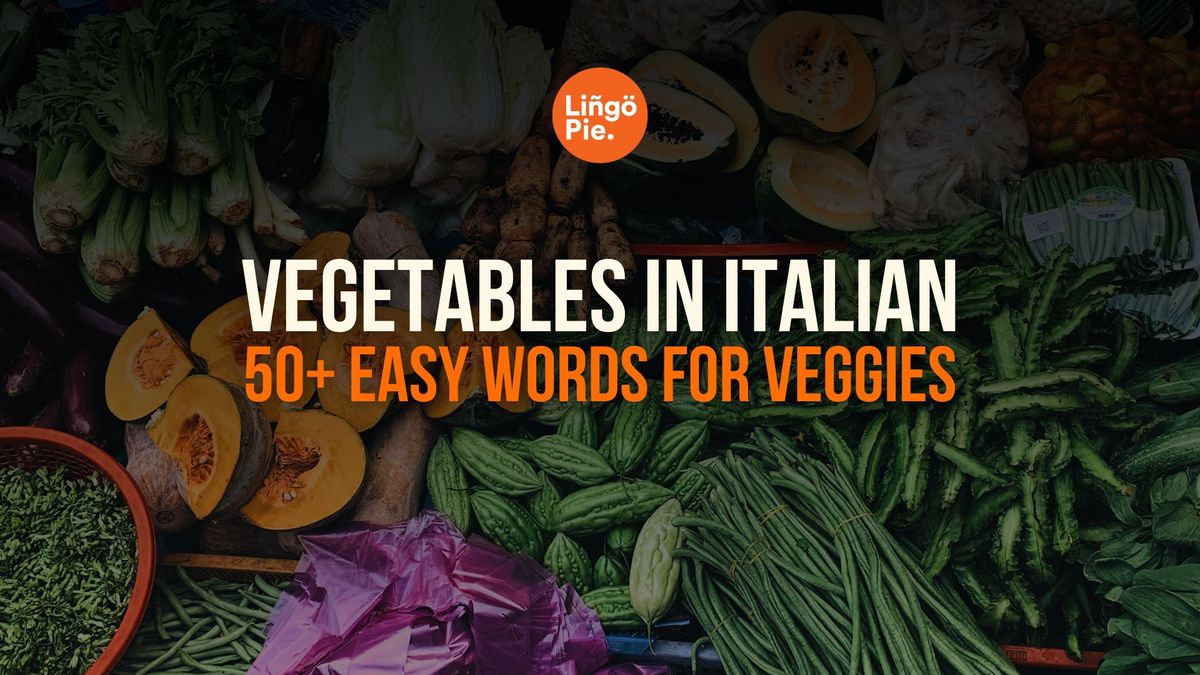Have you ever been to an Italian market? It's a feast for the eyes! In small Italian towns, Friday is market day. The streets fill up with stalls selling all kinds of fresh food, especially vegetables. It's colorful, noisy, and very Italian.
If you're learning Italian or planning a trip to Italy, knowing the names of vegetables in Italian can be super helpful. It'll make shopping at markets easier and more fun. Plus, you'll understand menus better and maybe even impress your Italian friends! In this guide, we'll learn over 40 easy Italian words for veggies.
Ready to spice up your Italian vocabulary? Let's get started!
📌 8 Italian Question Words Every Beginner Should Know
📌 12 Zodiac Signs In Italian: A Guide To Terms And Phrases
📌 20+ Terms For Accommodation In Italian

What Are Vegetables In Italian?
In Italian, the word for vegetable is "verdura" (singular) and "verdure" (plural). It's pretty simple to remember - just add an 'e' at the end for more than one vegetable!
When using these words, remember that "verdura" is feminine. This means you'll use "la" for "the" in the singular form and "le" for the plural. Here are some examples to show you how it works:
- La verdura è fresca. (The vegetable is fresh.)
- Mi piacciono le verdure. (I like vegetables.)
- Compro sempre le verdure al mercato. (I always buy vegetables at the market.)
It's worth noting that while "verdura" is the most common term for vegetables in Italian, you might also hear "ortaggio" (singular) or "ortaggi" (plural). These words are more formal and often used in culinary or botanical contexts. However, in everyday conversations and at the market, you'll mostly hear "verdura" and "verdure".


Most Common Vegetables In Italian
When you think of Italian food, you might picture pizza and pasta. But vegetables play a big role in Italian cuisine too! Famous Italian dishes with veggies include minestrone (a hearty vegetable soup), parmigiana di melanzane (eggplant parmesan), and insalata caprese (a salad with tomatoes, mozzarella, and basil). Italians simply love using fresh, seasonal vegetables in their cooking, whether it's in pasta sauces, on pizzas, or in side dishes called contorni.
Now, let's look at some common vegetables you'll find in Italian markets and kitchens. Knowing these will help you shop, order food, or talk about cooking with Italians.
Leafy Greens (Verdure a Foglia)
Italians love their leafy greens! These vegetables are often used in salads, sautéed as side dishes, or added to soups and pasta. They're a staple in the Mediterranean diet and are valued for their freshness and nutritional benefits.
| Italian | English |
|---|---|
| Spinaci | Spinach |
| Cavolo riccio | Kale |
| Lattuga romana | Romaine lettuce |
| Rucola | Arugula (Rocket) |
| Bietola | Swiss chard |
| Cavolo verza | Savoy cabbage |
| Lattuga | Lettuce |
| Cicoria | Chicory |
| Indivia | Endive |
| Cavolo nero | Tuscan kale |
Root Vegetables (Ortaggi a Radice)
Root vegetables are essential in Italian cooking, especially in hearty winter dishes. They're often roasted, used in soups, or served as contorni (side dishes). Many Italian comfort foods feature these versatile veggies.
| Italian | English |
|---|---|
| Carota | Carrot |
| Patata | Potato |
| Rapa | Turnip |
| Barbabietola | Beetroot |
| Sedano rapa | Celeriac |
| Pastinaca | Parsnip |
| Ravanello | Radish |
| Topinambur | Jerusalem artichoke |
| Zenzero | Ginger |
| Rafano | Horseradish |
Nightshade Vegetables (Ortaggi della Famiglia delle Solanacee)
Nightshade vegetables are stars in Italian cuisine. They're key ingredients in many famous dishes, from ratatouille-like caponata to eggplant parmigiana. These vegetables add rich flavors and vibrant colors to Italian cooking.
| Italian | English |
|---|---|
| Pomodoro | Tomato |
| Melanzana | Eggplant (Aubergine) |
| Peperone | Bell pepper |
| Peperoncino | Chili pepper |
| Pomodorino ciliegia | Cherry tomato |
| Pomodoro San Marzano | San Marzano tomato |
| Bacche di Goji | Goji berries |
Alliums (Alliacee)
Alliums form the flavor base of countless Italian dishes. Whether it's the aroma of sautéed onions or the punch of fresh garlic, these vegetables are essential in Italian kitchens. They're used in everything from pasta sauces to marinades for meats.
| Italian | English |
|---|---|
| Cipolla | Onion |
| Aglio | Garlic |
| Porro | Leek |
| Scalogno | Shallot |
| Cipollotto | Spring onion |
| Erba cipollina | Chives |
| Cipolla rossa | Red onion |
Squash And Gourds (Zucche e Cucurbitacee)
Squash and gourds are versatile vegetables in Italian cooking. From summer zucchini to winter pumpkins, these vegetables appear in dishes year-round. They're used in pasta fillings, soups, and even desserts.
| Italian | English |
|---|---|
| Zucca | Pumpkin |
| Zucchina | Zucchini (Courgette) |
| Zucchetta | Squash |
| Cocomero amaro | Bitter melon |
| Cetriolo | Cucumber |
| Chayote | Chayote |
| Luffa | Loofah (Sponge gourd) |
| Zucca Hokkaido | Hokkaido pumpkin |
| Patisson | Pattypan squash |
| Zucca butternut | Butternut squash |
Cruciferous Vegetables (Verdure Crucifere)
Cruciferous vegetables are popular in Italian regional cuisines, especially in the cooler northern regions. They're often featured in winter dishes, sautéed as side dishes, or used in hearty soups and stews.
| Italian | English |
|---|---|
| Cavolfiore | Cauliflower |
| Broccolo | Broccoli |
| Cavolo | Cabbage |
| Cavoletti di Bruxelles | Brussels sprouts |
| Cavolo rapa | Kohlrabi |
| Ravanello | Radish |
| Cavolo rosso | Red cabbage |
| Cavolfiore romanesco | Romanesco broccoli |
| Rucola | Arugula (Rocket) |
| Senape | Mustard greens |
| Cima di rapa | Turnip greens |
| Broccoletti | Broccolini |
| Kale (Cavolo riccio) | Kale |
| Cavolo cinese | Chinese cabbage |
| Daikon | Daikon radish |

Important Vegetables In Italian Cuisine
Italian cuisine is renowned for its use of fresh, seasonal vegetables. While all vegetables play a role, some stand out as particularly crucial. Let's explore the top 5 vegetables that are cornerstones of Italian cooking:
Pomodoro (Tomato)
The tomato reigns supreme in Italian cuisine, with Italy producing around 6 million tons annually. While grown throughout the country, the sun-drenched fields of Campania, Emilia-Romagna, and Sicily yield the most prized varieties. San Marzano tomatoes from the volcanic soils near Naples are particularly revered.
Here's a fun fact: Italians actually consume about 35 kg of tomatoes per person each year, using them fresh in salads during summer and as preserved sauces year-round.
Popular recipes featuring tomatoes:
- Pasta al pomodoro (Pasta with tomato sauce)
- Pizza Margherita
- Bruschetta al pomodoro
- Panzanella (Tuscan bread salad)
- Caprese salad
Melanzana (Eggplant)
Italy produces about 300,000 tons of eggplants yearly, with Sicily leading the production. The purple-black varieties are most common, but you'll also find striped or white eggplants in local markets. Sicilians and Calabrians are particularly fond of eggplant, incorporating it into numerous dishes.
Fun fact: An average Italian consumes about 4 kg of eggplant per year, but this number doubles in southern regions.
Popular recipes featuring eggplant:
- Parmigiana di melanzane (Eggplant parmesan)
- Pasta alla Norma
- Caponata (Sicilian eggplant relish)
- Melanzane ripiene (Stuffed eggplant)
- Melanzane sott'olio (Eggplant preserved in oil)
Zucchina (Zucchini)
Zucchini is versatile and widely used throughout Italy, appearing in dishes from appetizers to main courses. In regions like Liguria and Campania, smaller, flower-attached zucchini are prized for specific dishes. During the summer peak, locals often joke about the overwhelming abundance of zucchini in their gardens and markets.
Popular recipes featuring zucchini:
- Pasta alla Nerano
- Frittata di zucchine
- Zucchine ripiene (Stuffed zucchini)
- Parmigiana di zucchine
- Zucchine trifolate (Sautéed zucchini)
Carciofo (Artichoke)
Artichokes have been cultivated in Italy since ancient Roman times and are particularly popular in Rome and other central Italian regions.
Popular recipes featuring artichokes:
- Carciofi alla romana (Roman-style artichokes)
- Pasta con carciofi
- Frittata di carciofi
- Carciofi alla giudia (Jewish-style artichokes)
- Insalata di carciofi (Artichoke salad)
Spinaci (Spinach)
While not as flashy as some other vegetables, spinach is a staple in Italian cooking, used in everything from pasta fillings to side dishes. During the main seasons of autumn and spring, locals prefer to buy bunches of fresh spinach rather than pre-packaged leaves, believing the flavor to be superior.
Popular recipes featuring spinach:
- Lasagne agli spinaci
- Gnocchi di ricotta e spinaci
- Frittata di spinaci
- Spinaci alla fiorentina (Florentine-style spinach)
- Cannelloni ricotta e spinaci
Each of these vegetables plays a crucial role in Italian cuisine, reflecting the country's commitment to fresh, seasonal ingredients and simple yet flavorful dishes.

How To Learn Vegetables In Italian
Learning Italian vegetable names isn't just about expanding your vocabulary—it's a practical skill that will enhance your Italian experience, whether you're shopping at local markets, ordering in restaurants, or cooking authentic dishes at home. By mastering these words, you'll connect more deeply with Italian culture and cuisine.
To help you get started, I listed below some effective ways to learn Italian vegetable names quickly.
- Watching Italian cooking videos on YouTube - Seeing and hearing Italian veggie names can really help them stick in your mind. Plus, who doesn't love learning through our favorite influencers?
- Playing with flashcards - Whether you make your own or use an app, flashcards are great for quick practice. Shuffle them up and quiz yourself to keep things interesting.
- Cooking up some Italian recipes - Get your hands dirty with some Italian cooking! When you're chopping and cooking veggies yourself, those Italian names tend to stick better.
- Binging Italian food shows and movies - It's the perfect excuse to watch more TV. You'll hear how Italians really talk about veggies, and pick up some cultural tidbits too.
While these methods are effective, the best way to truly master Italian vegetable names—and the language as a whole—is through authentic media.
With Lingopie, you can watch Italian TV shows and movies that naturally incorporate these words into everyday conversations and situations. This immersive approach allows you to learn Italian while enjoying entertaining content. You'll pick up not just vocabulary, but also pronunciation, context, and cultural nuances.
Plus, Lingopie's interactive features let you pause, replay, and review new words, making your learning experience both enjoyable and efficient.
Learn Italian With Lingopie
Learning Italian vegetable names is not just easy—it's a delicious adventure! You'll find that many veggie names in Italian are similar to English, making them quick to pick up. Plus, exploring the colorful world of Italian produce is a fun way to connect with the language and culture. Before you know it, you'll be confidently navigating Italian markets and menus like a local.
But why stop at vegetables?
If you want to use these words in real Italian conversations, you'll need to boost your overall language skills. That's where Lingopie comes in handy! It's a fantastic tool that lets you learn Italian by watching authentic Italian TV shows and movies.

The best part? You can try Lingopie for FREE! Give it a go and see how quickly you can start chatting about your favorite veggies (and everything else) in Italian. Buon apprendimento! (Happy learning!)







![Happy New Year In Italian: 5+ Best Italian Greetings [Guide]](/blog/content/images/size/w300/2024/12/Happy-New-Year-In-Italian.jpg)


